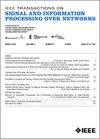Multi-Bit Distributed Detection of Sparse Stochastic Signals Over Error-Prone Reporting Channels
IF 3
3区 计算机科学
Q2 ENGINEERING, ELECTRICAL & ELECTRONIC
IEEE Transactions on Signal and Information Processing over Networks
Pub Date : 2024-11-20
DOI:10.1109/TSIPN.2024.3496253
引用次数: 0
Abstract
We consider a distributed detection problem within a wireless sensor network (WSN), where a substantial number of sensors cooperate to detect the existence of sparse stochastic signals. To achieve a trade-off between detection performance and system constraints, multi-bit quantizers are employed at local sensors. Then, two quantization strategies, namely raw quantization (RQ) and likelihood ratio quantization (LQ), are examined. The multi-bit quantized signals undergo encoding into binary codewords and are subsequently transmitted to the fusion center via error-prone reporting channels. Upon exploiting the locally most powerful test (LMPT) strategy, we devise two multi-bit LMPT detectors in which quantized raw observations and local likelihood ratios are fused respectively. Moreover, the asymptotic detection performance of the proposed quantized detectors is analyzed, and closed-form expressions for the detection and false alarm probabilities are derived. Furthermore, the multi-bit quantizer design criterion, considering both RQ and LQ, is then proposed to achieve near-optimal asymptotic performance for our proposed detectors. The normalized Fisher information and asymptotic relative efficiency are derived, serving as tools to analyze and compensate for the loss of information introduced by the quantization. Simulation results validate the effectiveness of the proposed detectors, especially in scenarios with low signal-to-noise ratios and poor channel conditions.在易出错报告信道上对稀疏随机信号进行多比特分布式检测
我们考虑的是无线传感器网络(WSN)中的分布式检测问题,即大量传感器合作检测稀疏随机信号的存在。为了在检测性能和系统约束之间实现权衡,我们在局部传感器上采用了多比特量化器。然后,研究了两种量化策略,即原始量化(RQ)和似然比量化(LQ)。多比特量化信号被编码成二进制编码字,随后通过易出错的报告信道传输到融合中心。利用局部最强检测(LMPT)策略,我们设计了两种多比特 LMPT 检测器,分别融合了量化原始观测值和局部似然比。此外,我们还分析了所提出的量化检测器的渐进检测性能,并得出了检测概率和误报概率的闭式表达。此外,还提出了同时考虑 RQ 和 LQ 的多比特量化器设计准则,以使我们提出的探测器达到接近最优的渐近性能。归一化费舍尔信息和渐近相对效率是用来分析和补偿量化带来的信息损失的工具。仿真结果验证了所提探测器的有效性,尤其是在信噪比低和信道条件差的情况下。
本文章由计算机程序翻译,如有差异,请以英文原文为准。
求助全文
约1分钟内获得全文
求助全文
来源期刊

IEEE Transactions on Signal and Information Processing over Networks
Computer Science-Computer Networks and Communications
CiteScore
5.80
自引率
12.50%
发文量
56
期刊介绍:
The IEEE Transactions on Signal and Information Processing over Networks publishes high-quality papers that extend the classical notions of processing of signals defined over vector spaces (e.g. time and space) to processing of signals and information (data) defined over networks, potentially dynamically varying. In signal processing over networks, the topology of the network may define structural relationships in the data, or may constrain processing of the data. Topics include distributed algorithms for filtering, detection, estimation, adaptation and learning, model selection, data fusion, and diffusion or evolution of information over such networks, and applications of distributed signal processing.
 求助内容:
求助内容: 应助结果提醒方式:
应助结果提醒方式:


